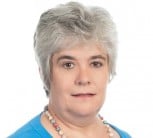Climate change in South Africa has major health risks associated with it, such as new vector-borne diseases emerging from heavy rainfall, malnutrition from poor food security caused by drought, and respiratory diseases caused by dust storms and air pollution.
Dr Caradee Wright, a researcher at UP’s Department of Geography, Geoinformatics and Meteorology, considered these health risks in a recent article in the journal Environmental Research.
“We are likely to experience increased temperatures that are double the global average of 2 degrees Celsius by the end of the century, which comes with increased risk of heat waves,” says Wright. “Changes in patterns of rainfall and the intensity of rainfall can come with massive floods, which in turn comes with the risk of diarrheal diseases.”
There is ample meteorological data available in South Africa but unfortunately Wright had trouble accessing health data to pair with the climate data for detailed models, especially for dust storms, for instance.
“Instead of focusing on what numbers we couldn’t find, we thought: let's look at what the risks are for South Africa, based on our knowledge of the threats that have been identified around the world and contextualise it from a South African climate change perspective,” she says. To do this, Wright worked with two other UP researchers - Prof Willem Landman, who specialises in meteorology, and Prof Liesl Dyson, who is an expert in severe weather events such as heavy rainfall.
The team put together what Wright calls a “quasi-systematic review” of the current climate data to assess the possible health risks associated with different climate change outcomes. Examples include an increase in respiratory illness caused by air pollution from fossil fuel emissions, and the increased risk of malnutrition caused by poor food security during droughts.
The researchers also point to the increased risk of malaria as mosquito numbers can surge when the perfect storm of heavy rainfall and a lack of predators occur after a prolonged drought.
The researchers cite the Intergovernmental Panel on Climate Change (IPCC) recommendation that mitigation and adaptation are the best ways to manage the effects of climate change on health in South Africa. Wright and the team suggest efforts from the health sector, like the National Health Insurance, which provide equal access to health care. She said it's also crucial to keep track of health data for tracking climate-sensitive diseases.
Mitigating health risks caused by climate change will require a concerted effort from many sectors that include government policy, the public understanding of climate change, and further research for more precise climate and health models.
“Every sector has been trying to deal with what’s within their domain, but unfortunately climate change does not work like that. It will take some creative thinking and working across disciplines.”

Dr Caradee Wright,
June 15, 2021

Professor Liesl Dyson studied Meteorology at the University of Pretoria (UP), which is the only university in South Africa that offers a degree in Meteorology that complies with the World Meteorology Organisation’s training standards. Prof Dyson has been doing research at UP for 25 years, and says “the beauty of clouds inspired me to study meteorology”.
As an associate professor in Meteorology in the Department of Geography, Geoinformatics and Meteorology, research is part of what she does. The research that she and her students are involved in deals with understanding the character of severe weather phenomena, investigating the development mechanisms of these phenomena and finding ways to better predict these events. As for how her research contributes to the betterment of the world, she says that timeous warnings of severe weather could save lives and property.
Many of the postgraduate students who do research under her supervision are employed at the South African Weather Service.
“Together, we identify which weather phenomena needs further investigation, then set about improving the understanding and forecasting of these,” Prof Dyson explains. “At the moment, there is special emphasis on severe thunderstorms. We investigate thunderstorms by using radar and state-of-the-art numerical weather prediction products. However, other phenomena such as sand/dust storms and snow are also included in our research.”
Prof Dyson collaborates with the Natural Hazard Centre, which statistically analyses the hail data she generates by using numerical weather prediction data and a hail model. The result of this collaboration determines the risk of hail over South Africa.
A highlight for her was being awarded the Water Research Commission’s Knowledge Tree Innovation Award in 2019 for a project entitled ‘The impact of the predictability of continental tropical lows on hydrological modelling: Current state and future projections’. This award celebrates outstanding design, process and product development of innovative technologies. The research investigated and named a specific type of tropical weather system over southern Africa, which they called Africánes. The system is a tropical cyclone-like low-pressure system that develops over Africa and causes very heavy rainfall over the sub-continent.
Two of the master’s students working under her supervision received the prestigious Society of South African Geographers Master’s Bronze Medal, which is awarded to the best geography MSc completed by research dissertation within a given year in South Africa. Christina Liesker received the award in 2022 for her work on supercell identification using weather radar and Markus Geldenhuys in 2019 for his work on the dangerous mountain wave phenomena over the Eastern Cape.
Prof Dyson’s role model in meteorology is Dr Jan Taljaard.
“I had the privilege of working with him for a short while when I was a young forecaster at the South African Weather Bureau. I admire him so much because he was an expert in real weather. It was all about what was going on outside and he instilled in me a hunger to do the same. He authored several papers about synoptic circulation over South Africa, and even though he has long since passed away, these documents are still my go-to papers when I do my own research. I discover new insights every now and again.”
Prof Dyson hopes to play a small part in helping weather forecasters in South Africa to be enthusiastic about the weather, be excellent in their jobs and have the knowledge through training and research to issue forecasts of high quality.
Research shows that in a changing climate, severe weather events are increasing. On short time scales, weather forecasters are responsible for issuing warnings for these events. Prof Dyson’s research matters because it aims to help forecasters to issue such warnings.
She says many young people are interested in the weather because they see and experience the effect of climate change and want to get involved in helping to address arising issues. Others are simply fascinated by tropical cyclones (hurricanes) and tornadoes, and by clouds. She advises school learners that in order to study meteorology, they need to take mathematics and natural science as subjects at school.
“We use Newton’s second law and the laws of thermodynamics to model the atmosphere, and learners need the mathematical tools to do that.”
Prof Dyson loves gardening in her spare time and enjoys outdoors activities with her dogs.
 Story
Story
University of Pretoria (UP) researchers have found that the antioxidant content of certain types of tea can be likened to that found in recommended portions of fruit and vegetables.
 Infographic
Infographic
Half a cup of black tea, oolong tea or green tea contained the same amount of antioxidants with radical scavenging capabilities (RSC) as that of a 200mg vitamin C tablet.
 Story
Story
Researchers at the University of Pretoria (UP) may have identified the gene that is responsible for diet-related obesity. By exploring the role of the novel gene Slc7a8, they have made a potential breakthrough in current knowledge about the cellular mechanisms that drive fat accumulation. This understanding is crucial in developing effective treatments.
Copyright © University of Pretoria 2025. All rights reserved.
Get Social With Us
Download the UP Mobile App